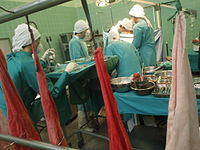
Photo from wikipedia
Background To evaluate the difference and efficacy of two donor liver procurement methods for treatment of pediatric acute liver failure (PALF) by living donor liver transplantation (LDLT). Methods A total… Click to show full abstract
Background To evaluate the difference and efficacy of two donor liver procurement methods for treatment of pediatric acute liver failure (PALF) by living donor liver transplantation (LDLT). Methods A total of 17 patients (12 men, 5 women) with PALF who underwent LDLT in our hospital between October 2016 and October 2020, and prognostic efficacy of donors and recipients using two donor liver procurement methods were analyzed. Results The donors and recipients were both divided into laparoscopic (7 cases) and open (10 cases) donor liver procurement groups. In the recipients, two deaths occurred in the laparoscopic group and one in the open group, and there were three postoperative complications in the laparoscopic group and six in the open group. The cumulative 1-year and 3-year survival rates in the laparoscopic group and the open group were 80.0% and 85.7% separately. There was no difference in the postoperative survival and complications rates between the two groups. In the donors, the operation time, postoperative hospital stay, and blood loss of the laparoscopic group was significantly reduced compared with the open group (P ≤ 0.01). No death or serious complication occurred in either donor group. Conclusion Laparoscopic donor liver procurement is worth recommending than open donor liver procurement for treatment of PALF combined with LDLT in qualified transplant centers.
Journal Title: Frontiers in Pediatrics
Year Published: 2022
Link to full text (if available)
Share on Social Media: Sign Up to like & get
recommendations!